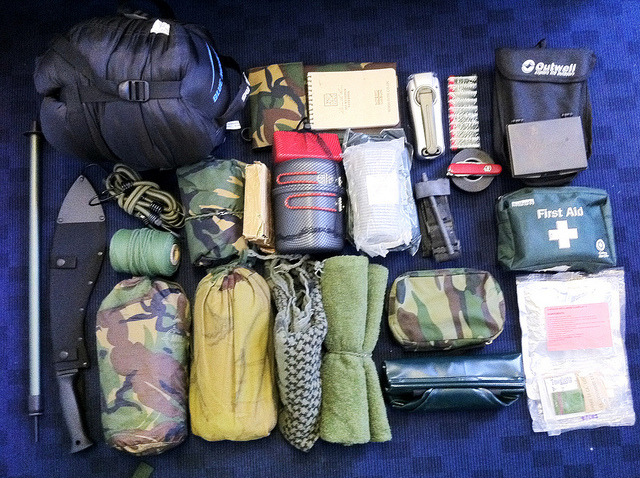The following is a small list of guidelines to help you plan ahead. Start building your bags now and keep them in an accessible location in case of an emergency. Here are some important steps to follow to make sure you're prepared when SHTF:
Rule 1: The Right Supplies
Your bug out bag is only as good as the supplies you put in it and the skills you have to use them…Here are a few suggestions for stocking your 72-hour bug out bag. But take this with a grain of salt… you need to customize this kit for your area, your needs, and your family.
Bug out Bag List The Right Gear For The Job:
First Aid Supplies
Adhesive bandages
Ace bandages
Rubbing alcohol
Hydrogen peroxide
Gauze pads
Tourniquet
Aspirin & ibuprofen
Tweezers ● Scissors
Bug spray
Sunscreen
30 days of prescription medications
Antibacterial ointment
Pepto Bismol
Clothing (per person)Three pairs of wool socks
Three pairs of underwear
Two pairs of pants
Two t-shirts
One long-sleeved undershirt
Jacket
long underwear (thermals)
something a little more risque?
Food and WaterWater bottles Water (two liters per person)
Electrolyte tabs or salt
Iodine tabs and cheesecloth Protein and nut bars Dehydrated fruits and meats MREs
ToolsCompass (practice so that you know how to use it before you need it)
Local maps
Small tool kit (screwdriver, pliers etc)
Hatchet
Collapsible shovel
Knife
Knife sharpener
Flashlight
Extra batteries
Small pan for heating waterShelter
Tent or tarp
Rope (to hang the tarp)
Foam pad (to prevent hypothermia)
Space blanket or emergency blanket (one per person)
Sleeping bagMiscellaneous
Toothbrush
Toothpaste
Dental floss
Ziploc bags
Trash bags
Duct tapeA Word On Premade Kits…
You can buy premade bug out bags that come with supplies. But keep in mind it may not have the items that you want or need, so your best bet is to build your own from scratch. Or use the premade kit as a springboard to create your personalized “ultimate” bug out bag.
Rule 2: The Plan
Something almost nobody thinks to include in a bug out bag is a written plan.
When disaster strikes, you’ll be distracted. It’s possible that you could be injured or incapacitated and somebody else in your family or group will have to lead the group to safety. The plan should include a list of what to take, directions for getting to the alternate location, and an alternate meeting place, should that be necessary.
In the event of a catastrophic failure of all systems, if you’ve written out your plan, you’ll be better able to safely and confidently get from point A to point B without forgetting anything.
Rule 3: The Execution
Make sure that you’ve practiced using the items in your bug out bag. A compass is useless if you don’t know how to use it—and using one is harder than it looks!
Practice starting a fire without matches. Check your food and medical items in your bag to make sure they have not expired and rotate them out as needed (practice FIFO- First in First Out).
Otherwise, leave the bag alone.
Do not “borrow” items from the bag for non-emergency situations.
If you do, you might forget to put the items back, and in the case of an emergency, you’ll be stuck without something vital that you need. While a bug out bag won’t prepare you for every scenario, it will help you get to the place where you have prepared for every eventuality.
Remember it's best to plan ahead now before anything happens because if an emergency situation arises, you don't want to stress about having enough supplies. Also make sure your bug out bag is in a place where you can get to it easily — the last thing you need is for SHTF and you have to run out to your garage to retrieve your bag!
Source: SurvivalLife.com
Featured Image via Flickr

John Araiza